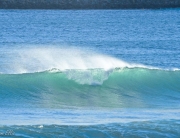Courtesy Australian Broadcasting Commission.
The study, published in Proceedings of the National Academy of Science, is the first ever experiment to look at what happens in people’s brains at the time they quench their thirst and when they drink more water than they want.
MRI scans show the brain clamps down on the swallowing reflex once we’ve had enough to drink, so we actually have to force ourselves to drink more than we need, says study co-author Dr Michael Farrell, of the Florey Institute of Neuroscience and Mental Health in Melbourne.
“It’s a biological mechanism in quite ancient parts of the brain, and it seems intent on stopping you from drinking too much,” says Farrell.
“If you are going to drink a lot of water that you don’t want you are going to have to override this mechanism.”
Many health authorities tell us we should drink about two litres — or eight glasses — of water a day.
But, says Farrell, there is actually very little empirical evidence to support this.
Indeed, he says available evidence suggests we tend to drink just the amount we need.
“Bingeing on water is not something that happens, usually,” says Farrell. “We know that when we try it’s quite hard to do.”
Drinking experiment
Farrell and colleagues got 19 study participants to work out on exercise bikes in a warm room.
After an hour, they weighed the participants and found they had lost approximately one per cent of their body weight in water due to sweating.
After they cooled down, and reported feeling thirsty, participants were placed into an MRI scanner and given a tube that delivered water into their mouth.
They were then taken out of the scanner and allowed to have as much water as they wanted.
But even after they were no longer thirsty, they were asked to keep drinking. Once they had imbibed more water than required to replace what they lost during the exercise, they were considered to be drinking more than their body needed.
At this stage the participants were placed back in the scanner with the water-delivery tube where they were asked to keep taking little sips.
The participants reported a pleasant feeling as they slaked their thirst for the first time, and the researchers found at this time increased activity in parts of the cingulate cortex associated with pleasant experiences.
However, the participants reported feeling increasingly unpleasant as they forced themselves to drink more and more water, beyond what they needed to satisfy their thirst.
At this stage, the researchers found that completely different brain circuits kicked in.
Brain circuits
First, there was increasing activity in regions of the motor cortex that control swallowing.
Second there was increased activity in several parts of the brain including the amygdala and periaqueductal gray (PAG) that have previously been shown to inhibit swallowing.
“Our interpretation is that the PAG and amygdala were sending messages to the swallowing switch to prevent it turning on,” says Farrell. “Consequently, the motor cortex had to send stronger than usual signals to turn the switch on.”
He says at the same time as swallowing is being inhibited, there is activation of a part of the cingulate cortex associated with unpleasant feelings.
And there is activation of a section of the brain called the insula, which receives sensory input from the gut and may be involved in monitoring the amount of water in the stomach, says Farrell.
“The overarching impression is that the brain coordinates drinking to ensure that water balance in the body is preserved.”
On wonders if the researchers took into consideration as people grow older they use the thirst reflex and do not know they are dehydrated?







Leave A Comment
You must be logged in to post a comment.